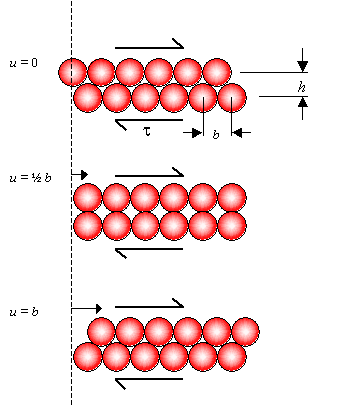Slip via dislocation motion
It is possible to estimate the stress required for slip by movement of lattice planes past one another (i.e. in a perfect crystal) and for slip by dislocation motion.
Stress required for slip in a perfect crystal
One can estimate the shear stress required to cause slip in a perfect crystal as follows. Imagine two close-packed planes with separation h and interatomic distance b. On application of a shear stress τ, the top plane moves a distance u with respect to the bottom plane as shown in the diagram.

The shear stress τ needed for slip to proceed in this way is zero when u = 0, u = ½ b and u = b etc. As a first approximation we assume that τ varies sinusoidally with u, then a suitable form for τ is:
$$\tau = {\tau _{crit}}\sin {{2\pi u} \over b}$$
where τcrit is a constant that equals the shear stress that must be applied to move one close-packed plane continuously over the next, and hence corresponds to the maximum value of τ. This maximum occurs when u = b/4.
τ is related to the shear strain γ by the shear modulus, G:
$$\tau = G\gamma $$
and the shear strain angle γ is given by
$$\gamma = {u \over h}$$
It is now possible to make the assumption that the ratio u/b is small since the macroscopic slip is the result of a small amount of slip on each plane, rather than a large amount on one plane. This simplifies the expression since sin x ~ x.
Combining equations [1] and [3],
$$\tau = {\tau _{crit}}\sin {{2\pi u} \over b} = 2\pi {\tau _{crit}}{{h\gamma } \over b}$$
Rearranging equation [2] and substituting,
$${\tau \over \gamma } = G = {{2\pi {\tau _{crit}}h} \over b}$$
hence
$${\tau _{crit}} = {{Gb} \over {2\pi h}}$$
For close-packed spheres, b/h = 2/31/2, which gives
$${\tau _{crit}} = {{Gb} \over {\pi \sqrt 3 }} \approx {G \over 5}$$
Stress required for slip by means of dislocation motion
When a dislocation line moves through a crystal, the interatomic forces across the slip plane are overcome in a series of local movements, rather than breaking all of the atomic bonds across the slip plane at once as would occur in a perfect lattice. The stress needed to drive a dislocation through a crystal continuously is called the Peierls-Nabarro stress, τp. Calculation of τp is difficult, and it depends on the ratio of the dislocation width w to the magnitude of the Burgers vector b. One simple model gives:
$${\tau _p} = 3G\exp \left( { - {{2\pi w} \over b}} \right)$$
Setting w = b, which is the minimum reasonable width for a dislocation, and therefore will give the maximum τp, reduces equation [6] to:
$${\tau _p} = 3G\exp ( - 2\pi ) \approx {G \over {180}}$$
This approximate calculation shows that the Peierls-Nabarro stress to move a dislocation through a lattice (equation [7]) is orders of magnitude less than the stress required to cause slip in a perfect lattice (equation [5]). Therefore it follows that slip occurs by dislocation motion when dislocations are present in the lattice.

